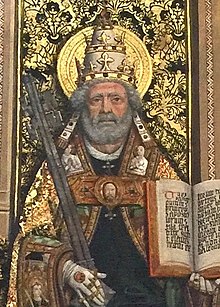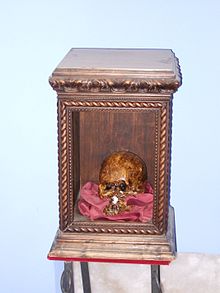Antipope Benedict XIII
Benedict XIII | |
|---|---|
| Pope Luna | |
 | |
| Elected | 28 September 1394 |
| Papacy began | 11 October 1394 |
| Quashed | 12 March 1403 |
| Papacy ended | 23 May 1423 |
| Predecessor |
|
| Successor |
|
| Opposed to | Roman claimants:
|
| Other post(s) | Cardinal-Deacon of Santa Maria in Cosmedin |
| Orders | |
| Ordination | 3 October 1394 by Jean de Neufchatel |
| Consecration | 11 October 1394 by Jean de Neufchatel |
| Created cardinal | 20 December 1375 |
| Rank | Cardinal-Deacon |
| Personal details | |
| Born | Pedro Martínez de Luna y Pérez de Gotor 25 November 1328 |
| Died | 23 May 1423 (aged 94) Peniscola, Crown of Aragon |
| Buried | Castillo Palacio del Papa Luna, Illueca (skull) |
| Occupation | Professor |
| Previous post(s) | Apostolic Administrator of Avignon (1394–1398) |
| Alma mater | University of Montpellier |
| Coat of arms |  |
| Other popes and antipopes named Benedict | |
Pedro Martínez de Luna y Pérez de Gotor (25 November 1328 – 23 May 1423), known as el Papa Luna in Spanish and Pope Luna in English, was an Aragonese nobleman who, as Benedict XIII, is considered an antipope (see Western Schism) by the Catholic Church.
Early life
Pedro Martínez de Luna was born at
Avignon election
In 1377, Pedro de Luna and the other
Clement VII sent de Luna as legate to Spain for the Kingdoms of Castile, Aragon, Navarre, and Portugal, in order to win them over to the obedience of the Avignon pope. Owing to his powerful relations, his influence in the Province of Aragon was very great. In 1393, Clement VII appointed him legate to France, Brabant, Flanders, Scotland, England, and Ireland. As such he stayed principally in Paris, but he did not confine his activities to those countries that belonged to the Avignon obedience.[1] Following Clement's death on 16 September 1394, the cardinals met at Avignon. The conclave consisted of 11 French cardinals, eight Italians, four Spaniards, and one from Savoy, all proclaiming the ardent wish to reunite the church. The cardinals then elected Luna as the new pope, on the condition that he should labor to quell the schism, and should resign the papal dignity whenever the pope of Rome should do the same, or the college of cardinals demand it.

On the death of Urban VI in 1389, the Roman College of Cardinals had chosen Boniface IX; the election of Benedict therefore perpetuated the Western Schism. At the start of his term of office, de Luna was recognised as pope by
Avignon papacy

In 1398, the Kingdom of France withdrew its recognition of the Avignon anti-popes.[3] Benedict was abandoned by 17 of his cardinals, with only five remaining faithful to him. Benedict's rationale for continuing the rivalry lay in the fact that he was the last living cardinal created by Gregory XI, the last undoubted pope. As the only unquestioned cardinal, Benedict argued, he was, by right and by canon law, the only qualified candidate left who could validly claim the papacy. Following the Council of Constance Benedict's logic was not widely accepted.
An army led by
After the Roman Pope Innocent VII died in 1406, the newly elected Roman pope, Gregory XII, started negotiations with Benedict, suggesting that they both resign so a new pope could be elected to reunite the Catholic Church. When these talks ended in stalemate in 1408, Charles VI of France declared that his kingdom was neutral to both papal contenders. Charles helped to organise the Council of Pisa in 1409. This council was supposed to arrange for both Gregory and Benedict to resign, so that a new universally recognised pope could be elected. To oppose this, Benedict convoked the Council of Perpignan but with little success. Since both Benedict and Gregory refused to abdicate, the only achievement in Pisa was that a third candidate to the Holy See was put forward: Peter Philarghi, who assumed the name Alexander V.[4]
University of St Andrews

A group of

Etsi doctoribus gentium
In part to bolster faltering support for his papacy, Benedict initiated the year-long
Council of Constance
In 1415, the Council of Constance brought this clash between papal claimants to an end. Gregory XII agreed to resign, and Baldassare Cossa, who had succeeded Philarghi as the Pisan papal contender in 1410 and had assumed the name John XXIII, tried to flee and was deposed during his absence, being subsequently tried upon his return. Benedict, on the other hand, refused to stand down.
Finally,
Because of this stubbornness, the Council of Constance declared Benedict a
Succession
The day before his death, Benedict appointed four cardinals of proven loyalty to ensure the succession of another pope who would remain faithful to the now beleaguered Avignon line. Three of these cardinals met on 10 June 1423 and elected Sanchez Muñoz as their new pope, with Muñoz assuming the papal name of Clement VIII, whose claim was still recognised by Aragon. The fourth cardinal, Jean Carrier, the archdeacon of Rodez near Toulouse, was absent at this conclave and disputed its validity, whereupon Carrier, acting as a sort of one man College of Cardinals, proceeded to elect Bernard Garnier, the sacristan of Rodez, as pope. Garnier took the name Benedict XIV,[11] but he would never get any importance.
When, in 1429, an agreement between Rome and Aragon was reached, Clement VIII abdicated in favour of recognising
Burials

Benedict XIII was buried in
. Aragon, Spain. In April 2000, it was stolen from the now ruined palace. The thieves sent an anonymous letter to the mayor of Illueca asking for 1,000,000 Pts (€6,000). TheAttempted rehabilitation
On 21 December 2018, the association "Friends of Pope Luna" presented to the
See also
- Papal selection before 1059
- Papal conclave (since 1274)
Notes
- ^ a b c Kirsch, Johann Peter. "Pedro de Luna." The Catholic Encyclopedia Vol. 9. New York: Robert Appleton Company, 1910. 2 January 2016
- ^ The pope was repeatedly urged by Catherine of Siena: McGinn, Bernard The Varieties of Vernacular Mysticism, (Herder & Herder, 2012), p. 561. Other considerations were the repeated embassies sent by the Roman people, and the war of Florence against the cities of the Papal States.
- ^ McBrien, Richard P., Lives of the Popes, (HarperCollins, 1997), p. 250.
- ^ ISBN 978-0-89141-110-9.
- ^ Great Britain. Commission for Visiting the Universities and Colleges of Scotland (1837). University of St. Andrews. W. Clowes and Sons. pp. 173–.
- ^ Beinart, Haim (2008). "Tortosa, Disputation of". Jewish Virtual Library. Retrieved 21 June 2009.
- ^ Grayzel, Solomon (2008). "Bulls, Papal". Jewish Virtual Library. Retrieved 9 July 2014.
- ^ Wasserman, Henry (2008). "Goldsmiths and Silversmiths". Jewish Virtual Library. Retrieved 13 July 2014.
- ^ Ansbacher, B. Mordechai (2008). "Books". Jewish Virtual Library. Retrieved 13 July 2014.
- OCLC 893847466.
- ^ Pham, John-Peter. Heirs to the Fisherman: Behind the Scenes of Papal Death and Succession. Oxford: Oxford University Press, 2004. 331-332.
- ^ "El robo del cráneo del Papa Luna se queda en una multa". El Periódico de Aragón (in Spanish). 7 November 2006. Retrieved 22 March 2021.
- ^ Campo, Ramón J. "El cráneo del Papa Luna: historia de un robo | Reportaje especial en Heraldo.es". www.heraldo.es (in Spanish). Retrieved 22 March 2021.
- ^ La rehabilitación del Papa Luna. https://www.lasprovincias.es/comunitat/rehabilitacion-papa-luna-20190211232314-ntvo.html
- ^ Allen Jr., John L. "Push to rehabilitate past pope illustrates great truth about the present". Archived from the original on 12 February 2019.
Accounts of his life
The Anti-pope (Peter de Luna, 1342–1423): A study in obstinacy by Alec Glasfurd, Roy Publishers, New York (1965) B0007IVH1Q is a somewhat fictionalised or imaginative account of his life.
Pluja seca by Jaume Cabré (2001) is a play based on his death and succession.
L'Anneau du pêcheur ("The Ring of the Fisherman"— a play on the words pêcheur, meaning fisherman, and pécheur, meaning sinner) is a 1995 novel by the French writer Jean Raspail. The narrative has two timelines: the time of Benedict XIII, the last antipope of the Avignon Papacy, and contemporary times, when the Catholic Church tries to discover Benedict's successor, as it turns out that his line of papacy has continued in secret throughout the centuries. The book received the Prix Maison de la Presse and the Prince Pierre Foundation's Literary Prize.[citation needed]
References
- . The American Cyclopædia. 1879.
- Herbermann, Charles, ed. (1913). . Catholic Encyclopedia. New York: Robert Appleton Company.
- Chow, Gabriel. "Antipope Benedict XIII (1394–1423)". GCatholic.org. Toronto. Retrieved 6 December 2010.
- Hughes, Philip E. (1 January 1947). A History of the Church:Volume 3: The Revolt Against the Church: Aquinas to Luther. London: ISBN 978-0-7220-7983-6.
